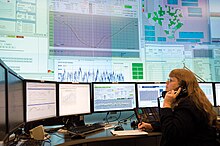ERCOT
 |
|
 |
|
| Type | ERCOT is a membership-based 501(c)(4) nonprofit corporation, governed by a board of directors and subject to oversight by the Public Utility Commission of Texas and the Texas Legislature. |
|---|---|
| Headquarters | Taylor, TX and Austin, TX |
| Website | http://www.ercot.com |
The Electric Reliability Council of Texas (ERCOT) manages the flow of electric power on the Texas Interconnection that supplies power to 24 million Texas customers – representing 85 percent of the state's electric load. ERCOT is the first independent system operator (ISO) in the United States and one of nine ISOs in North America. ERCOT works with the Texas Reliability Entity (TRE), one of eight regional entities within the North American Electric Reliability Corporation (NERC) that coordinate to improve reliability of the bulk power grid.
As the ISO for the region, ERCOT dispatches power on an electric grid that connects 40,500 miles of transmission lines and more than 550 generation units. ERCOT also performs financial settlements for the competitive wholesale bulk-power market and administers retail switching for 6.7 million premises in competitive choice areas.
ERCOT is a membership-based 501(c)(4) nonprofit corporation, governed by a board of directors and subject to oversight by the Public Utility Commission of Texas (PUC) and the Texas Legislature.
ERCOT's members include consumers, electric cooperatives, generators, power marketers, retail electric providers, investor-owned electric utilities (transmission and distribution providers), and municipally owned electric utilities.
Power demands in the ERCOT region are highest in summer, primarily due to air conditioning use in homes and businesses. The ERCOT region's all-time record peak hour occurred on August 10, 2015, when consumer demand hit 69,877 MW. A megawatt of electricity can power about 200 Texas homes during periods of peak demand.
At the beginning of World War II, several electric utilities in Texas agreed to operate together as the Texas Interconnected System (TIS) to support the war effort. Excess power generation was sent to industries on the Gulf Coast, providing a more reliable supply of electricity for production of metal and other material needed for the war.
Recognizing the reliability advantages of remaining interconnected, TIS members continued to operate and develop the interconnected grid. TIS members adopted official operating guides for their interconnected power system and established two monitoring centers within the control centers of two utilities, one in North Texas and one in South Texas.
...
Wikipedia
